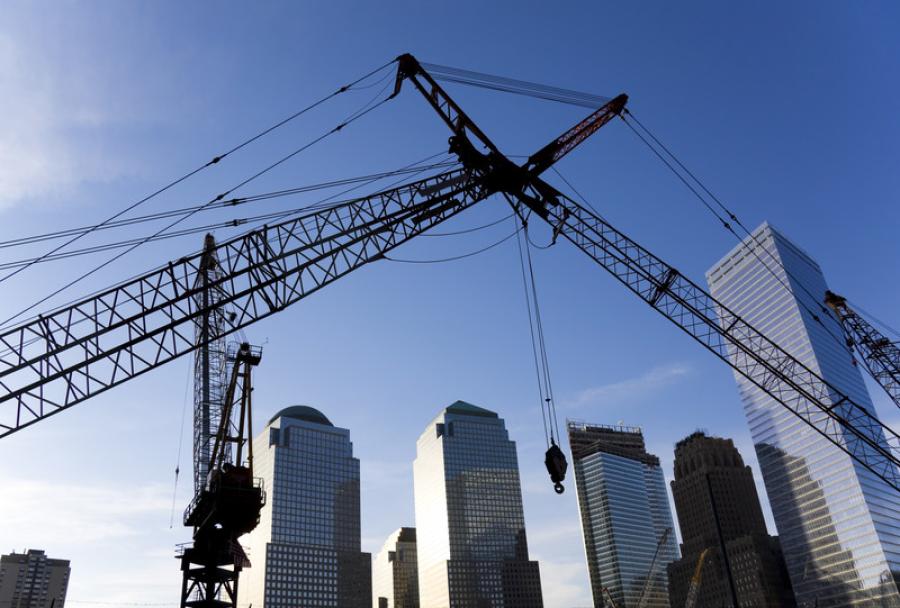
Wed June 22, 2016
Brenda Ruggiero
The Crane Technical Working Group released an interim report on June 10 that includes 23 recommendations in regard to crane safety.
The group was established by New York Mayor Bill de Blasio and Buildings Commission Rick Chandler following a crane collapse on Feb. 5. The accident involved a Liebherr LR1300 crawler crane at 60 Worth Street, Manhattan. One person died and another was seriously injured. The crane was set up to install a new generator and cooling tower on a building. The cause of the accident remains under investigation.
The introduction to the report notes that the recommendations reflect the Working Group's “independent expertise in engineering and government; a thorough assessment of crane regulations in cities around the world that, like New York, have dense urban cores; and input from the city's construction industry, who also have a great stake in ensuring that our cranes are the safest in the world.”
The executive summary states that construction in a vertical city requires cranes.
“New York City's crane regulations are among the most comprehensive in the world,” it goes on to say. “They cover all phases of a crane's life cycle — from design and manufacturing at the factory; to maintenance, repair, and inspection in the crane yard; to installation and operation at a construction site.”
Further, the summary notes that the city's crane regulations were last comprehensively revised in 2008, with provisions specific to tower cranes added in 2008. Then in 2015, the Department of Buildings launched a new effort to update the city's crane regulations. The report notes that this ongoing effort, along with the recommendations made, represents an opportunity for crane safety improvement.
“These forward-looking recommendations could make New York's crane regulations — already the strongest in the country — even more effective,” Chandler said. “I thank the Working Group for offering their time and expertise to make our city safer. In the coming days, my team and I will fully evaluate this report. The group's recommendations are solid, sensible, and doable.”
The recommendations include the following provisions:
• That cranes be equipped with anemometers, data-logging devices (“black boxes”), and GPS tracking so that cranes can be more closely monitored.
• That additional industry oversight be implemented — both periodically and prior to use each day, similar to how airplanes are readied for flight.
• That the Department of Buildings return to its previous practice of issuing advisories, rather than cease-operations orders, except in extreme weather events, since forecasts are not site specific, and crane operators should not wait for DOB guidance before taking action; cranes rated for lower wind speeds have already been prohibited from city streets; and the recommendations in this report greatly enhance DOB's ability to monitor compliance with regulations.
The group recommends using the latest technology, including data loggers, GPS tracking, electronic record keeping, and anemometers. In addition, private meteorological services to provide pinpoint forecasting are recommended, as well as placing an age limit on cranes and using self-erecting tower cranes.
Greater industry accountability is another part of the group's recommendations. This includes third party crane certifiers for comprehensive inspection, risk-based plan examination, and the adjustment of staffing models to address cyclical work and the need for specialized expertise.
In addition, the group recommends crane assembly/disassembly supervision, post-assembly inspection, the appointment of a lift director, pre-shift meetings and inspections, the monitoring of weather conditions during work, department-issued advisories in advance of inclement weather, post-shift checks, clear indications of wind speed thresholds and the securing sequence, restrictions on cranes with lower wind thresholds, and focused city coordination.
Training and licensing enhancements are also recommended, including orientation for cranes with a long boom/jib configuration and the creation of a specific licensing endorsement for such cranes.
The Working Group, which was tasked to report its findings and recommendations within 90 days, includes Mary C. Boyce, dean of engineering at the Fu Foundation School of Engineering and Applied Science at Columbia University; Wayne A. Crew, general secretary of the National Academy of Construction; Bill Goldstein, who most recently served as senior advisor to the Mayor for recovery, resiliency and infrastructure; Peter J. Madonia, chief operating officer of the Rockefeller Foundation; and Katepalli R. Sreenivasan, president of NYU Polytechnic School of Engineering and dean of engineering at New York University.
According to the group, the investigation is continuing, and a final report that may include additional safety recommendations will be released upon its completion.
 Cranes Equipment
Cranes Equipment Articles
Articles Email Updates
Email Updates Sell Your Machines
Sell Your Machines

 Cranes Equipment
Cranes Equipment Cranes Dealers
Cranes Dealers Cranes Articles
Cranes Articles Email Updates
Email Updates Sell Your Machines
Sell Your Machines